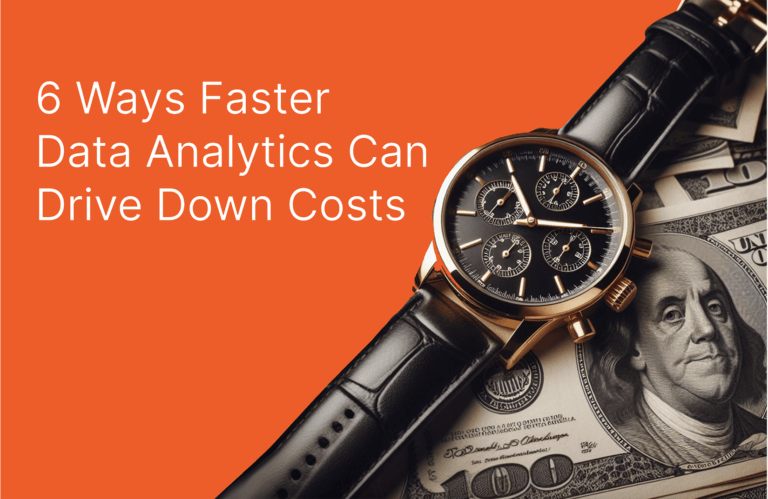Companies depend more on their data every day, particularly when it comes to making decisions that drive more revenue or, alternatively, reduce cost. Big data analytics can help to predict emerging trends, cut down on operational costs, and invest where it counts.
In a study of 500 global IT decision makers, 86% of respondents noted plans to increase use of data to improve or optimize operational costs more in 2023 from 2022.¹ What are some of those key use cases for analytics to drive down costs? Let’s take a look.
Target Ad Campaigns for Fewer Wasted Marketing Dollars
Big data has helped businesses deliver effective marketing campaigns in a digital-first era, moving away from mass-marketing to targeted and personalized strategies.
Businesses can now capture data from every customer touchpoint, giving them a better understanding of both customer behavior and intent. By evaluating customer behavior, companies can create strategic marketing plans that target a particular customer cohort—for example, by offering personalized recommendations based on previous purchases or social media activity.
In the case of performance marketing, advertising costs are billed when a targeted online user performs a certain action, such as clicking on a paid advertisement. Using data from customers who have taken similar actions, big data analytics can identify the variables that are most likely to influence a customer’s click. In this way, big data analysis results in less wastage, making advertising more relevant and less expensive to carry out. In fact, one Forrester study found that 37% of marketers waste budget unnecessarily because of poor quality data. More complete data allows them to deploy their marketing dollars more strategically by creating and executing better-targeted marketing campaigns.
Avoid Financial Impact of Supply Chain Disruptions
Supply chains generate massive amounts of data, including internal historical sales data, supplier performance records, point of sale consumer data, and landed cost data. Through digitization, companies can gather and analyze this data to identify problem patterns, bottlenecks, and other opportunities to reduce costs.
According to data compiled by IBM, 84% of chief supply chain officers (CSCOs) report that a lack of supply chain visibility is the biggest challenge they face. Supply chain digitization can improve traditional systems with real-time location and business data from across the entire supply chain. This creates a single, central source of information for end-to-end visibility, improving efficiency and preventing disruptions.
Agility is also vital in supply chain management. With a digitized supply chain, organizations can glean valuable insights from real-time status reports, resulting in faster decision-making, a stronger ability to identify service area gaps, and opportunities to boost performance and optimize connections with customers and suppliers.
Prevent Loss with Better Fraud Detection
Fraud can be costly for a business in any industry. Big data can help organizations discover trends that point towards suspicious activity to reduce fraud and thwart criminal efforts. SIEM system analytics and security log data can also help prevent malicious activity.
For example, retailers can build profiles and set thresholds for normal customer behavior regarding the purchase of a specific product over a period of time. With this baseline established, retailers can then identify behaviors that may indicate return fraud. Retailers can then blacklist these customers or take other actions to help prevent return fraud.
Enhance Log Analytics
Log events, audit trail records, and even simple logs can all provide useful insight into the activity that is occurring across systems. This data can then be used to understand user behavior, improve application or infrastructure performance issues, proactively mitigate risk, and ensure compliance with security policies, audits, and regulations.
Log analysis can also help with resource management. Forecasting is challenging, but when you understand current resource usage and future requirements, you can head off waste or overspend. Also, businesses can detect where their systems need extra capacity for better performance and identify underutilized assets that can be restructured and optimized to improve productivity, efficiency, and performance.
For DevOps and IT teams, insights from log data can react to issues faster, shortening the time needed to detect and resolve production problems. Log analysis can also give insight into issues before they occur, allowing teams to be proactive by identifying issues and their root causes before they cause downtime or other performance issues.
Make Better Customer Service Table Stakes
Poor customer service can result in a loss of sales, but it also keeps businesses from earning valuable lifetime customers. In most cases, it costs more to win new customers than to keep existing customers happy, as attracting new customers can require costly promotional campaigns.
With big data, companies can also identify the activities that keep current customers satisfied. Data from surveys, reviews, and other online and offline customer feedback mechanisms can help businesses create post-sales strategies that improve customer retention.
CRM system data can create accurate customer profiles that help contact centers quickly get up to speed on customer issues and provide faster service to resolve problems. Data analytics can help businesses identify weak areas in their customer service strategies to enhance the way they interact with customers.
Drive Productivity and Efficiency with Real-time Data
The availability of real-time data can play a vital role in improving productivity and operational efficiency within a company. Analytics software solutions can be used to produce reports that cut through the noise that big data collection generates. Managers, employees, and customer service reps can use these easily digestible reports to pinpoint the exact information they need.
Data can also increase productivity within teams, improve hiring methods to help managers recruit and keep the best talent, and give insights on effective management and training methods that improve employee satisfaction and performance.
As more data becomes available, AI and machine learning algorithms can give better insights that improve operational efficiency, lead to greater efficiency, and help companies deliver better services to their customers—all of which contribute to lower expenses.
Accelerate Big Data Analytics with Pure Storage®
Big data holds a wealth of information that can help organizations direct financial resources more efficiently to optimize expenses and significantly reduce costs. Get more value from your data with a modern data infrastructure that can accelerate decision making, simplify operations, and power analytics. All-flash data storage solutions like Pure Storage® FlashBlade® can help you leverage big data to make better, faster business decisions.
Like this article and want to read more? Sign up for our monthly Perspectives email today. And we promise not to spam you, just inform and inspire you!
![]() ¹Pure Storage and Bredin IT Research 2022 survey.
¹Pure Storage and Bredin IT Research 2022 survey.






